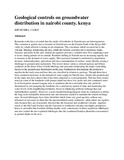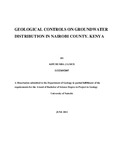| dc.description.abstract | Research works have revealed that the yields of boreholes in Nairobi area are heterogeneous.
This variation is greatly due to location of Nairobi area on the Eastern flank of the Kenya Rift
valley by which affected it during its development. The volcanism which occurred led to the
volcanic lithology dominating the area, while the tectonic activities led to numerous faults,
fractures and joints in the area. Indeed the aquifers provide a valuable base flow supplying water
to rivers during periods of no rainfall. Borehole drilling in Nairobi area is increasing rapidly due
to increase in the demand of water supply. This increased demand is attributed by population
increase, industrialization, agriculture and also contamination of surface waters thereby posing a
challenge to groundwater exploration. The review hence carries a critical analysis and library
synthesis on the direct effect of both lithology and structures delineating the major controlling
factors in the groundwater distribution in the area. Furthermore discriminate the productive
aquifers in the study area and how they are classified in relation to geology.
Though there have been continued increases in the demand of water supply in Nairobi area,
already the groundwater in the study area have shown that it has been subjected to
overexploitation. This has been clearly noted in some of the boreholes with greater depth but
show low yields and also continued water level fluctuations around Langata area, to minimize
this it is advisable that safe yields be determined by test pumping the boreholes for a satisfactory
period of time and monitoring the water levels of the neighboring boreholes, however enhancing
artificial recharge that can replenish these aquifers. However, a more detailed hydrogeological
study be conducted to define the long-term sustainable abstraction rate and measures needed to
maintain the related recharge rates.
Several lithologies have been identified which form very good aquifers without any influence of
structures in them like the unconsolidated sandy sediments, while others are aquifers only
because they are structurally affected like the fractured and weathered volcanic. Aquifers struck
at the Old Land Surface and the fractured or weathered volcanics are highly productive, hence is
advisable that borehole drilling depths verily concentrate on these aquiferous lithologies and also
exploit the less exploited lithologies like the weathered Kandizi phonolites encountered at greater
depths in the area. | en |


